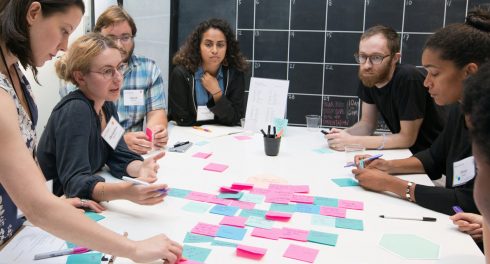
Storytelling for advocacy is a challenge, especially in transparency work, where the characters are often lawyers—or laws—and not mythical heroes. As advocates who want to make a point to make a change, we need vivid imagery to deliver our message, especially because the changes we seek can be hard to explain.
We seek compelling stories the same way those heroes seek magic hammers and hidden temples. We’re on a quest for stories that can remake the world. But—spoiler alert—the quest often ends in disappointment.
In a series of recent interviews, program officers, communications experts, and civil society leaders said that a shortage of memorable anecdotes and a lack of time and expertise are among the most common obstacles to telling “results stories” about transparency and accountability.
 Our TAI report, “The Story Behind the Story,” draws on those interviews to explore what it takes to create stories. It reveals a range of uses for story among donors and their grantees, compiles many of their story challenges, and highlights several storytelling recommendations.
Our TAI report, “The Story Behind the Story,” draws on those interviews to explore what it takes to create stories. It reveals a range of uses for story among donors and their grantees, compiles many of their story challenges, and highlights several storytelling recommendations.
However, while we discovered a number of valuable techniques for effective storytelling, the most compelling, useful stories we heard were not about story tools but story processes—or, more pointedly, about the core activities of grant-making, implementation, reporting, and communications, and how these fundamental processes enable and inhibit the creation of results stories.
Behind the booming interest in storytelling lie the less glamorous demands of story-making, which call on organizations to seek and share information across gaps of power and distance, and through barriers of organizational habit and culture.
Donors know that even though a good story travels farther and faster than a humdrum report, good stories are hard to find. Whether their aim is to win over policymakers or to showcase grantees, donors face a perennial shortage of compelling, persuasive results stories.
For grantees, the stakes are even higher. A well-told story about organizational impact can make the difference between a grant renewal and a staff reduction. Facing the cyclical precipice of donor support, NGOs and community-based organizations need results stories to sway not only public and policymaker audiences, but their own funders.
Expertise and capacity are perennial challenges, but more striking were grantees’ constraints on sharing stories of unexpected outcomes, or failure. Grantees lack the freedom to tell it like it is. Most “don’t know how to communicate a failure without it looking like you’re useless,” one grantee said.
And while the donor-grantee relationship may be especially stifling for difficult stories, donor teams are not immune to the problem. Several donors acknowledged that an appetite for success affects which stories get shared even inside foundation walls. Bad news doesn’t travel upward easily.

Photo: rawpixel at Pixabay
“The Story Behind the Story” presents this landscape of content, capacity, and culture challenges, and highlights some of the solutions these groups have found. We then go a step further, suggesting a number of experiments, new approaches, and changes of habit that could help donors and grantees improve the pool of stories available to them and the power of those stories to promote learning and change. Some of the reports key insights include:
We need to broaden our definitions of outcomes and results. Our sector’s conception of impact is narrow. We leave knowledge—perhaps even success—unrecognized when we design our programs, grants, and communications around the norm of “big bang” impacts. We spoke with a number of TAI donors who are now exploring what results mean beyond the constraining dichotomy of success or failure. We also explored ideas for how to rethink the business side of grant-making to allow for complexity. If stories are for learning, and not just for bragging or box-ticking, then we must broaden our vocabulary for talking about “what happened.”
We need to talk. The processes of grant-making, communications, evaluation and learning operate in siloed proximity to each other. Stories, and the raw material that drives story, are our medium for sharing information, but our information channels are disconnected by functional role, by the grant-making cycle, and by the distance between foundation offices and grantee communities. “We’re all harvesting and we’re all in the same field,” said one donor we talked to, “but none of us can see one another.” By creating stronger, earlier consultation between communications, reporting, and learning functions, we can create stronger story processes, better stories and faster learning and adaptation.
We need to enable local groups to tell their own stories on their own terms. When donors define the goals, terms, and deliverables of their grants, they inevitably influence the terms on which grantees talk about their work. “It appears that many donors do not trust communities to identify accountability and transparency needs,” one grantee leader said, and when donors have “rigid frameworks,” it increases the chance that “success is reported, but nowhere is change to be found on the ground.” Another grantee said, “To make stories ‘presentable,’ takes reality away.” Donors can’t simply mine stories from the field to suit their own uses. Grantees must be permitted to take the lead.
We must allow mixed results and bad news to travel upward, between grantees and donors and within NGOs and donor offices. Grant-making culture inhibits the sharing of disappointments and failures. For all the hype about “failing fast,” we’re still failing pretty quietly. But we also heard signs of hope, from donors utilizing less binary evaluative tools, such as the Most Significant Change technique, and from a few grantees who felt supported when they initiated difficult conversations with donors. One story trainer said, “Failing is not necessarily a bad thing as long as there are learnings along the way, chances to take that experience on board and adapt.” A donor neatly bookended this same sentiment, saying, “You have to provide some sort of analysis about why you think something didn’t work … clarity about what you expected to happen.”
It’s a moment of opportunity for storytelling in transparency and accountability. Not only have we recognized the limitations of the stories we’ve been telling for the last decade—about technology, about open government, about civil society itself—but we’re also beginning to invest in new approaches to collaboration that use and produce stories more conscientiously. Among the TAI donors, several groups focused on learning and strategy are piloting new models for consultation about grant outcomes and challenges. And grantmaking experts are establishing new projects directly focused on stories, such as The Narrative Initiative.
“Stories are a critical way to understand the why and how of change,” as one expert told us. “They help test our assumptions and improve our interventions.” This dual role of story is one of the most valuable threads from our report.
The potential of storytelling as a tool is understood, even if great stories remain hard to find. But I wanted to do more than compile storytelling methods or offer a TED-like tribute to the power of story. Our report seeks to understand the process that finds and supports stories and explores how that process can undergird our programs and grantmaking cycles, at every stage. With greater understanding, donors, grantees, and the cast of characters who support them will be better prepared for the quest.
#thestorybehindthestory
Click here to DOWNLOAD the report

Jed Miller is a digital strategist who helps mission-driven organizations think before they build things. He has worked with groups including Global Witness, Greenpeace, the Laura and John Arnold Foundation, and the World Bank, among others. Jed was previously internet director for the Revenue Watch Institute (NRGI) where he conceived and developed the open contracting platform ResourceContracts.org. Prior to that, Jed was the first digital director of the American Civil Liberties Union. He has taught advocacy communications at Columbia’s School for International Public Affairs and has written for the Guardian, the Open Society Foundations, and Civicist, among others. He lives in Washington, D.C. @jedmiller


